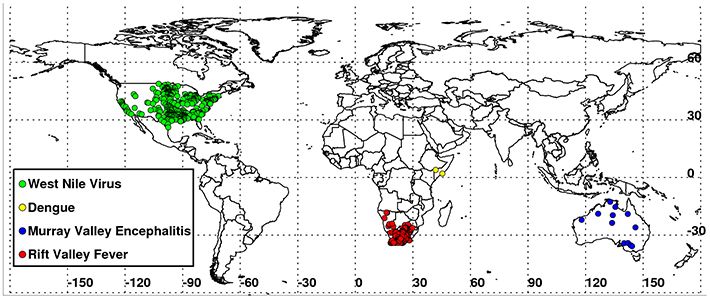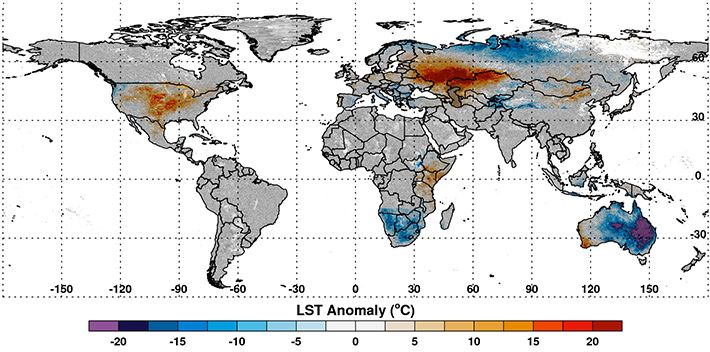Research Page
Ecologically Coupled Diseases
Climate and weather fluctuations leading to extreme temperatures, storm surges, flooding, and droughts produce conditions that precipitate mosquito-borne disease epidemics directly affecting global public health. Abnormally high temperatures affect populations of mosquito disease vectors by influencing: mosquito survival; susceptibility of mosquitoes to viruses; mosquito population growth rate, distribution, and seasonality; replication and extrinsic incubation period of a virus in the mosquito; and virus transmission patterns and seasonality.
Extreme increases in precipitation may increase mosquito larval habitats or create new habitats and an overall increase in mosquito vector populations. For instance, the probability of vector survival can increase with humidity. Unusually low rainfall or drought can also change habitats by concentrating water into small pools, potentially increasing the proportion of container breeding mosquito vectors.
Concurrently, these anomalous patterns of temperature and precipitation have impacts on the vertebrate hosts of disease vector mosquitoes. Increased rain can increase vegetation, habitat, food availability, and thus survival of vertebrate host populations. Decreased rain can severely reduce or eliminate food resources forcing vectors and vertebrate hosts into human settlements, increasing vector-human contact.
The ability to monitor and map at a global scale variations in precipitation, land surface temperature and vegetation anomalies enables us to determine periods and regions that are likely to have disease outbreaks. We apply a variety of NASA and NOAA satellite-derived measurements (including those of precipitation (TRMM, GPM, GPCP), normalized difference vegetation index (NOAA-AVHRR, Aqua/Terra MODIS), land surface temperature (Aqua/Terra MODIS) as well sea surface temperatures to quantify the nature and patterns of variability.

Image Source: Anyamba A, Small JL, Britch SC, Tucker CJ, Pak EW, Reynolds CA, et al. (2014) Recent Weather Extremes and Impacts on Agricultural Production and Vector-Borne Disease Outbreak Patterns. PLoS ONE 9(3): e92538. doi:10.1371/journal.pone.0092538
At interannual time scale, we monitor the phases of El Niño/Southern Oscillation (ENSO) phenomenon, that is well known climate fluctuation that results in extremes in precipitation and temperature in various teleconnection regions and associated clusters of disease outbreaks including Rift Valley fever, cholera, plague, chikungunya, dengue, Ross River virus, Murray Valley encephalitis among others.
The ultimate aim is to build early warming systems customized to for specific regions and overall to provide global early warning for potential disease outbreaks.
PIs: Assaf Anyamba, Compton J. Tucker
Extreme increases in precipitation may increase mosquito larval habitats or create new habitats and an overall increase in mosquito vector populations. For instance, the probability of vector survival can increase with humidity. Unusually low rainfall or drought can also change habitats by concentrating water into small pools, potentially increasing the proportion of container breeding mosquito vectors.
Concurrently, these anomalous patterns of temperature and precipitation have impacts on the vertebrate hosts of disease vector mosquitoes. Increased rain can increase vegetation, habitat, food availability, and thus survival of vertebrate host populations. Decreased rain can severely reduce or eliminate food resources forcing vectors and vertebrate hosts into human settlements, increasing vector-human contact.
The ability to monitor and map at a global scale variations in precipitation, land surface temperature and vegetation anomalies enables us to determine periods and regions that are likely to have disease outbreaks. We apply a variety of NASA and NOAA satellite-derived measurements (including those of precipitation (TRMM, GPM, GPCP), normalized difference vegetation index (NOAA-AVHRR, Aqua/Terra MODIS), land surface temperature (Aqua/Terra MODIS) as well sea surface temperatures to quantify the nature and patterns of variability.

Image Source: Anyamba A, Small JL, Britch SC, Tucker CJ, Pak EW, Reynolds CA, et al. (2014) Recent Weather Extremes and Impacts on Agricultural Production and Vector-Borne Disease Outbreak Patterns. PLoS ONE 9(3): e92538. doi:10.1371/journal.pone.0092538
At interannual time scale, we monitor the phases of El Niño/Southern Oscillation (ENSO) phenomenon, that is well known climate fluctuation that results in extremes in precipitation and temperature in various teleconnection regions and associated clusters of disease outbreaks including Rift Valley fever, cholera, plague, chikungunya, dengue, Ross River virus, Murray Valley encephalitis among others.
The ultimate aim is to build early warming systems customized to for specific regions and overall to provide global early warning for potential disease outbreaks.
PIs: Assaf Anyamba, Compton J. Tucker

